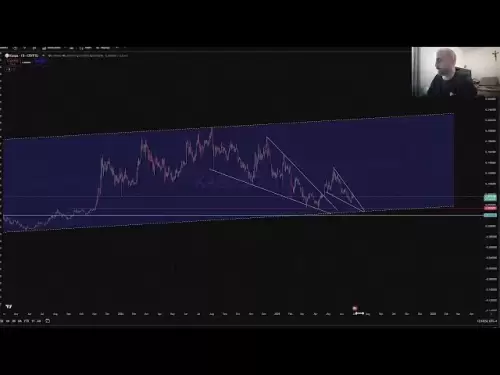-
 Bitcoin
Bitcoin $107,352.1067
0.28% -
 Ethereum
Ethereum $2,429.3531
-0.90% -
 Tether USDt
Tether USDt $1.0001
-0.02% -
 XRP
XRP $2.1894
4.62% -
 BNB
BNB $646.7968
0.36% -
 Solana
Solana $147.4290
4.03% -
 USDC
USDC $0.9998
-0.02% -
 TRON
TRON $0.2756
1.52% -
 Dogecoin
Dogecoin $0.1630
1.14% -
 Cardano
Cardano $0.5612
1.18% -
 Hyperliquid
Hyperliquid $37.0580
-0.05% -
 Bitcoin Cash
Bitcoin Cash $496.9410
-0.09% -
 Sui
Sui $2.7318
3.19% -
 Chainlink
Chainlink $13.1503
0.58% -
 UNUS SED LEO
UNUS SED LEO $9.0766
0.55% -
 Avalanche
Avalanche $17.7220
1.46% -
 Stellar
Stellar $0.2380
1.52% -
 Toncoin
Toncoin $2.8439
0.38% -
 Shiba Inu
Shiba Inu $0.0...01143
1.84% -
 Litecoin
Litecoin $85.8053
1.47% -
 Hedera
Hedera $0.1483
2.70% -
 Monero
Monero $314.3240
2.12% -
 Bitget Token
Bitget Token $4.6725
0.77% -
 Dai
Dai $1.0000
0.00% -
 Polkadot
Polkadot $3.3555
1.28% -
 Ethena USDe
Ethena USDe $1.0001
0.02% -
 Uniswap
Uniswap $7.0890
2.64% -
 Pi
Pi $0.5355
-3.40% -
 Pepe
Pepe $0.0...09393
1.06% -
 Aave
Aave $256.8136
-1.90%
BingX contract calculation formula
Understanding the BingX contract calculation formula empowers traders to navigate the complex world of contract trading, calculate contract value, profit and loss, funding rate payments, margin requirements, and liquidation parameters effectively.
Nov 25, 2024 at 08:10 am

BingX Contract Calculation Formula: A Comprehensive Guide
Understanding the calculation formula behind a contract trading platform is crucial for successful trading. BingX, a leading cryptocurrency exchange, offers a comprehensive set of contract types with distinct calculation methods. This guide delves deep into the BingX contract calculation formula, providing a step-by-step explanation of each component to empower traders with the knowledge they need to navigate the complex world of contract trading.
Step 1: Understanding Contract Basics
- Contract: A contract is a financial instrument that represents an agreement to buy or sell an underlying asset at a predetermined price on a future date.
- Mark Price: The mark price is a real-time index price derived from the weighted average of recent trades on multiple exchanges. It serves as the reference price for contract calculations.
- Index Price: The index price is a reference price that reflects the underlying asset's spot market value. It is typically based on data from reputable data providers.
- Funding Rate: The funding rate is a periodic payment made between long and short positions to ensure that the contract price remains closely aligned with the index price.
- Leverage: Leverage is a mechanism that allows traders to amplify their potential profits and losses by borrowing funds from the exchange. It is expressed as a ratio, such as 10x or 20x.
Step 2: Calculating Contract Value
- Contract Value = Contract Size Mark Price Leverage
- Contract Size: The contract size represents the number of underlying assets represented by each contract.
- Mark Price: The mark price is the reference price used for contract valuation.
- Leverage: The leverage applied to the position increases the potential profits or losses.
For example: A BTCUSDT contract with a contract size of 0.01 BTC, a mark price of $20,000, and a leverage of 10x would have a contract value of $20,000 0.01 10 = $20,000.
Step 3: Calculating Profit and Loss (PnL)
- Unrealized PnL = (Mark Price - Entry Price) Contract Size Leverage
- Mark Price: The current mark price of the contract.
- Entry Price: The price at which the position was entered.
- Contract Size: The number of underlying assets represented by each contract.
- Leverage: The leverage applied to the position.
For example: If the mark price of the BTCUSDT contract rises to $20,500 and the entry price was $20,000, the unrealized PnL would be ($20,500 - $20,000) 0.01 10 = $500.
- Realized PnL = (Exit Price - Entry Price) Contract Size Leverage
- Exit Price: The price at which the position was exited.
- Entry Price: The price at which the position was entered.
- Contract Size: The number of underlying assets represented by each contract.
- Leverage: The leverage applied to the position.
For example: If the BTCUSDT contract is closed at $21,000, the realized PnL would be ($21,000 - $20,000) * 0.01 * 10 = $1,000.
Step 4: Calculating Funding Rate Payment
- Funding Rate Payment = Funding Rate Contract Size Funding Rate Interval
- Funding Rate: The periodic payment rate between long and short positions.
- Contract Size: The number of underlying assets represented by each contract.
- Funding Rate Interval: The time interval at which the funding rate is applied.
For example, if the funding rate is 0.01%, the contract size is 0.01 BTC, and the funding rate interval is 8 hours, the funding rate payment would be 0.01% 0.01 8 = 0.000008 BTC.
Step 5: Margin Management
- Initial Margin = Contract Value * Initial Margin Ratio
- Contract Value: The value of the contract calculated using the formula in Step 2.
- Initial Margin Ratio: The percentage of the contract value required as collateral.
- Maintenance Margin = Contract Value * Maintenance Margin Ratio
- Contract Value: The value of the contract calculated using the formula in Step 2.
- Maintenance Margin Ratio: The minimum percentage of the contract value that must be maintained as collateral to prevent liquidation.
Step 6: Liquidation
- Liquidation Price = Mark Price * Liquidation Threshold
- Mark Price: The current mark price of the contract.
- Liquidation Threshold: The price level at which a position is automatically closed out to prevent further losses.
- Liquidation Fee = Liquidation Price * Liquidation Fee Rate
- Liquidation Price: The price at which the position is liquidated.
- Liquidation Fee Rate: The fee charged by the exchange for liquidating a position.
By thoroughly understanding the BingX contract calculation formula, traders gain a powerful tool for evaluating profit potential, managing risk, and making informed trading decisions.
Disclaimer:info@kdj.com
The information provided is not trading advice. kdj.com does not assume any responsibility for any investments made based on the information provided in this article. Cryptocurrencies are highly volatile and it is highly recommended that you invest with caution after thorough research!
If you believe that the content used on this website infringes your copyright, please contact us immediately (info@kdj.com) and we will delete it promptly.
- RUVI Token Soars: Can It Eclipse Cardano's Forecast?
- 2025-06-29 02:30:12
- Meme Coin Mania: Can Little Pepe Outshine Shiba Inu and Dogecoin?
- 2025-06-29 02:30:12
- XRP Tokens: Navigating Financial Status and the Art of Buying In
- 2025-06-29 02:50:12
- Shiba Inu, Trump Coin, and the Crypto Bull Run: What's the Deal?
- 2025-06-29 03:50:12
- Coinbase on the 2025 List of Influential Companies: A Crypto Powerhouse?
- 2025-06-29 04:10:12
- Solana, Shiba Inu, and Pepe Coin: What's Hot and What's Not in the Crypto World
- 2025-06-29 03:55:13
Related knowledge

How to use the price slope to filter the false breakthrough signal of the contract?
Jun 20,2025 at 06:56pm
Understanding the Concept of Price Slope in Contract TradingIn contract trading, especially within cryptocurrency derivatives markets, price slope refers to the rate at which the price changes over a specific time period. It helps traders assess the strength and sustainability of a trend. A steep slope may indicate strong momentum, while a shallow slope...

How to determine the expected volatility of the contract through the volatility cone?
Jun 19,2025 at 12:28pm
Understanding the Basics of Volatility in Cryptocurrency ContractsIn the realm of cryptocurrency trading, volatility is a key metric that traders use to assess potential risk and reward. When dealing with futures contracts, understanding how volatile an asset might become over time is crucial for position sizing, risk management, and strategy developmen...

How to formulate a contract intraday trading plan in combination with the pivot point system?
Jun 21,2025 at 03:42pm
Understanding the Basics of Pivot Points in Cryptocurrency TradingPivot points are technical analysis tools used by traders to identify potential support and resistance levels. These levels are calculated using the previous day's high, low, and closing prices. In the context of cryptocurrency trading, where markets operate 24/7, pivot points help trader...

How to adjust the contract position ratio through the price fluctuation entropy?
Jun 22,2025 at 11:42am
Understanding Price Fluctuation Entropy in Cryptocurrency ContractsIn the world of cryptocurrency futures trading, price fluctuation entropy is a relatively new concept used to measure market volatility and uncertainty. It derives from information theory, where entropy refers to the degree of randomness or unpredictability in a system. In crypto contrac...

How to use the volume swing indicator to predict the contract volume-price divergence?
Jun 18,2025 at 11:42pm
Understanding the Volume Swing IndicatorThe volume swing indicator is a technical analysis tool used primarily in cryptocurrency trading to evaluate changes in volume over time. Unlike price-based indicators, this metric focuses solely on trading volume, which can provide early signals about potential market reversals or continuations. The key idea behi...

How to use the Gaussian channel to set the contract trend tracking stop loss?
Jun 18,2025 at 09:21pm
Understanding the Gaussian Channel in Cryptocurrency TradingThe Gaussian channel is a technical indicator used primarily in financial markets, including cryptocurrency trading, to identify trends and potential reversal points. It is based on statistical principles derived from the normal distribution, commonly known as the Gaussian distribution or bell ...

How to use the price slope to filter the false breakthrough signal of the contract?
Jun 20,2025 at 06:56pm
Understanding the Concept of Price Slope in Contract TradingIn contract trading, especially within cryptocurrency derivatives markets, price slope refers to the rate at which the price changes over a specific time period. It helps traders assess the strength and sustainability of a trend. A steep slope may indicate strong momentum, while a shallow slope...

How to determine the expected volatility of the contract through the volatility cone?
Jun 19,2025 at 12:28pm
Understanding the Basics of Volatility in Cryptocurrency ContractsIn the realm of cryptocurrency trading, volatility is a key metric that traders use to assess potential risk and reward. When dealing with futures contracts, understanding how volatile an asset might become over time is crucial for position sizing, risk management, and strategy developmen...

How to formulate a contract intraday trading plan in combination with the pivot point system?
Jun 21,2025 at 03:42pm
Understanding the Basics of Pivot Points in Cryptocurrency TradingPivot points are technical analysis tools used by traders to identify potential support and resistance levels. These levels are calculated using the previous day's high, low, and closing prices. In the context of cryptocurrency trading, where markets operate 24/7, pivot points help trader...

How to adjust the contract position ratio through the price fluctuation entropy?
Jun 22,2025 at 11:42am
Understanding Price Fluctuation Entropy in Cryptocurrency ContractsIn the world of cryptocurrency futures trading, price fluctuation entropy is a relatively new concept used to measure market volatility and uncertainty. It derives from information theory, where entropy refers to the degree of randomness or unpredictability in a system. In crypto contrac...

How to use the volume swing indicator to predict the contract volume-price divergence?
Jun 18,2025 at 11:42pm
Understanding the Volume Swing IndicatorThe volume swing indicator is a technical analysis tool used primarily in cryptocurrency trading to evaluate changes in volume over time. Unlike price-based indicators, this metric focuses solely on trading volume, which can provide early signals about potential market reversals or continuations. The key idea behi...

How to use the Gaussian channel to set the contract trend tracking stop loss?
Jun 18,2025 at 09:21pm
Understanding the Gaussian Channel in Cryptocurrency TradingThe Gaussian channel is a technical indicator used primarily in financial markets, including cryptocurrency trading, to identify trends and potential reversal points. It is based on statistical principles derived from the normal distribution, commonly known as the Gaussian distribution or bell ...
See all articles

























































































